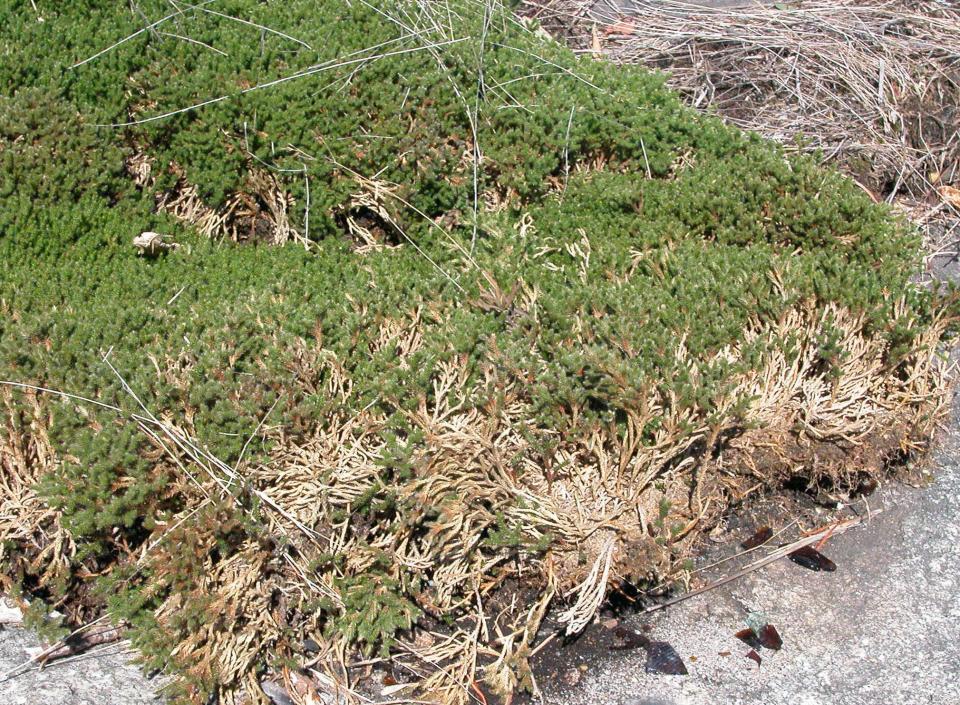Diminutive plant grows on inhospitable rocky elevations | Mystery Plant
No gaudy flowers for this humble little earthling. No flowers at all! Not even seeds. Here’s a plant that reproduces solely by spores, and shares affinities with the familiar ferns.
Some people might look at this plant and think it’s a moss of some sort: but, no, it’s not a moss: its tissues are richly supplied with vascular tissue (xylem and phloem, of course) for conducting water and solutes. The “true” mosses lack such conducting tissues.
Our Mystery Plant (Spike-moss, Bryodesma tortipilum) is one of about 90 similar species, all belonging to the same genus, and mostly distributed in North America. They are all diminutive plants, just a few inches tall, but often occurring in massive growths, forming patches or extensive mats. And, they are frequently found in arid habitats, either on open rock or on bare sand.

Growing in inhospitable places can be a struggle, so plants growing in such places must have adaptations for dealing with extremes in solar radiation and surface temperatures, as well as extremely dry environments. The plants produce wiry stems with plenty of short, wispy leaves, each with a tiny curved bristle at the tip.
These leaves are very simple structures, and anatomically, aren’t exactly the same kind of “true” leaves found on a maple tree or a rose bush.
Although they have little or no human economic value, these various species are quite important in their natural settings. Those, especially, that thrive on bare rock are effective in trapping sand and sediment, allowing colonization by other, often larger plants, and providing habitat for a variety of small critters.
The spores are produced in special pouches at the base of a leaf. There are two different kinds of spores: “megaspores” are relatively large, and they end up producing a tiny structure bearing egg cells. The “microspores” are much smaller, and they eventually supply tiny sperm cells that effect fertilization. The plants represented by the leafy mats are ultimately the result of this kind of fertilization, which, as you might expect, can only take place when there is a film of water covering the plants, either from rain or dew.
The plant pictured here represents one of the various species which grows only on open rock, known to occur at high elevations in the Carolinas and Georgia. You’ll also see some broken glass on the rock surface, which suggests human visitation.
Sure enough, open flatrock habitats and domes have always been attractive to people, for a variety of reasons, for thousands of years. Recreational possibilities abound in such places, but unfortunately, most flatrock sites in the Southeast are currently threatened by destructive activities of their human visitors, activities including bonfires, spray-painting, smashing bottles, and joy-riding.
Sadly, many of the best sites we know of have been seriously harmed in this way, with the resultant loss of characteristic plant life, including a number of rare species. Fortunately, there are several excellent examples of protected flatrock ecosystems available for responsible visitation and hiking.
John Nelson is the retired curator of the Herbarium at the University of South Carolina, in the Department of Biological Sciences. As a public service, the Herbarium offers free plant identifications. For more information, visit www.herbarium.org or email johnbnelson@sc.rr.com.
This article originally appeared on Tallahassee Democrat: Diminutive spike-moss grows on rocky elevations | Mystery Plant

